 Website:
Shearwell Data Ltd
Website:
Shearwell Data Ltd
Catalog excerpts

Shearwell Data Livestock Systems Heatwave® Handbook
Open the catalog to page 1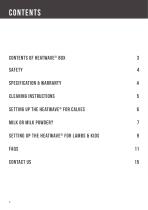
SETTiNG up ThE HEATwAvE® For CALvES 6 milk or milk powder? 7 setting up ThE heatwave® For lambs & KidS 9
Open the catalog to page 2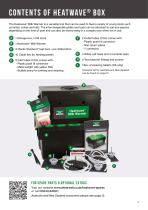
Contents of heatwave ® box The Heatwave® Milk Warmer is a versatile tool that can be used to feed a variety of young stock such as lambs, calves and kids. The interchangeable plates and teats can be attached to suit any species depending on the time of year and can also be stored away in a compact box when not in use. A • 1 Storage box / milk store C • 2 Plastic Stokbord® teat bars - pre drilled 9mm F • 2 Outlet tubes (1.2m) comes with: - Plastic push fit connector - Non return valves - Y connector D • 10 Cable ties for feeding panels G • 4 White calf teats and 4 red lamb teats E • 2 Inlet...
Open the catalog to page 3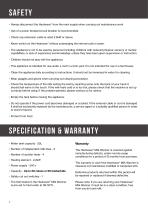
• Always disconnect the Heatwave® from the main supply when carrying out maintenance work. • Use of a power breaker/circuit breaker is recommended. • Check any extension cable is rated 2.5kW or above. • Never switch on the Heatwave® without submerging the internal coils in water. • The appliance is not to be used by persons (including children) with reduced physical, sensory or mental capabilities, or lack of experience and knowledge, unless they have been given supervision or instruction. • Children should not play with the appliance. • This appliance is intended for use under a roof in a...
Open the catalog to page 4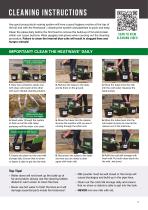
CLEANING INSTRUCTIONS Any good young stock rearing system will have a good hygiene routine at the top of the list and with the Heatwave®, cleaning the system and pipelines is quick and easy. Clean the pipes daily before the first feed to remove the build-up of fat and protein which can cause bacteria. Wear goggles and gloves when carrying out the cleaning procedure. Failure to clean the internal blue coils will result in clogged lines and hungry animals! SCAN TO VIEW CLEANING VIDEO IMPORTANT! CLEAN THE HEATWAVE® DAILY Dissolve 1 cleaning tablet in 5L of warm water 1. Have two containers...
Open the catalog to page 5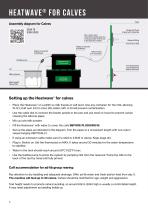
Heatwave ® for Calves Gate Assembly diagram for Calves SCAN To VIEW VIDEO Stokbord® xed to gate with cable ties Non-return valve Important to keep valve in a vertical position with arrow in the direction of feed Plastic connector & Bulkhead Plastic connector & Bulkhead Bubble pump Silicone tube to Y-connector Heatwave tank Fill with water For lambs & kids place heatwave tank at oor level Lid Milk container Heatwave Storage Box Metal weight Yellow lter Setting up the Heatwave® for calves • P lace the Heatwave® on a plinth so milk travels at ‘calf level’. Use any container for the milk,...
Open the catalog to page 6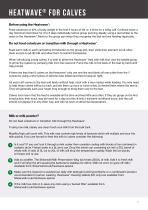
Heatwave ® for Calves Before using the Heatwave®: Feed colostrum at 10% of body weight in the first 6 hours of life i.e. 4 litres for a 40kg calf. Continue twice a day (minimum 2x2 litres) for 3 to 5 days individually, before group penning. Ideally, using a teat similar to the ones on the Heatwave®. Move to the group pen when they recognise the teat and are feeding vigorously. Do not feed colostrum or transition milk through a Heatwave®. Feed warm milk to each calf before introduction to the group pen, then while their stomach is full, allow them access to ad-lib milk and allow them to...
Open the catalog to page 7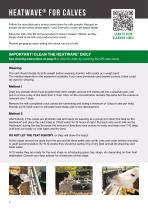
Heatwave ® for Calves Follow the manufacturer’s mixing instructions for milk powder. Request an instant version which mixes tepid / cold. One with a lower pH keeps better. Store the milk cold. Do not be tempted to feed a ‘weaker’ dilution as they simply drink more milk and produce more urine! SCAN TO VIEW CLEANING VIDEO Prevent gorging by never letting the calves run out of milk. IMPORTANT! CLEAN THE HEATWAVE® DAILY See cleaning instructions on page 5 or view the video by scanning the QR code above. Weaning The calf should double its birth-weight before weaning, monitor with scales or a...
Open the catalog to page 8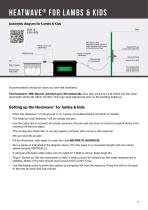
Heatwave ® for Lambs & kids Assembly diagram for Lambs & Kids SCAN To VIEW VIDEO Non-return valve Important to keep valve in a vertical position with arrow in the direction of feed Plastic connector & Bulkhead Bubble pump Plastic connector & Bulkhead Silicone tube to Y-connector Lid Milk container Metal weight Yellow lter Heatwave tank Fill with water Stokbord® xed to gate with cable ties Bayonet tting (not in AU or NZ) For lambs & kids place heatwave tank at oor level Accommodation should be clean, dry and well ventilated. The Heatwave® Milk Warmer will feed up to 50 lambs/kids. One teat...
Open the catalog to page 9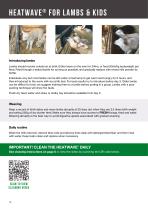
Heatwave ® for lambs & kids Introducing lambs Lambs should receive colostrum at birth. Either leave on the ewe for 24hrs, or feed 50ml/kg bodyweight per feed. Feed through a teated bottle for as long as possible, and gradually replace with mixed milk powder by bottle. Individuals vary but most lambs can be left under a heat lamp to get warm and hungry for 6 hours, and then introduced to the warm milk via ad-lib teat. For best results try to introduce before day 3. Older lambs can be difficult to train, we suggest training them to a bottle before putting in a group. Lambs with a poor sucking...
Open the catalog to page 10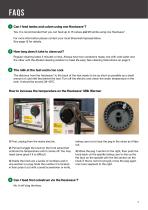
Can I feed lambs and calves using one Heatwave®? Yes. It is recommended that you can feed up to 15 calves and 25 lambs using one Heatwave®. For more information please contact your local Shearwell representative. See page 15 for details. 2 How long does it take to clean out? Regular cleaning takes 5 minutes or less. Always have two containers ready, one with cold water and the other with the diluted cleaning solution to make life easy. See cleaning instructions on page 5. 3 The milk at the teat end is too cool. The distance from the Heatwave® to the back of the teat needs to be as short as...
Open the catalog to page 11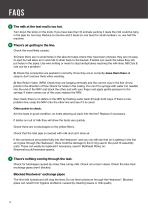
Faqs 5 The milk at the teat end is too hot. Turn down the temp on the knob. If you have less than 10 animals sucking 4 teats the milk could be lying in the pipe for too long. Reduce to one line and 2 teats (or one teat) for small numbers. i.e. use half the machine. 6 There’s air getting in the line. Check the most likely causes: 1) Check there are no small holes in the silicone tubes where they have been chewed, they are not easy to spot but will allow air in and milk to drain back to the bucket. If lambs can reach the tubes they will put holes in the pipes. Use wire netting or mesh to stop...
Open the catalog to page 12All Shearwell Data Ltd catalogs and technical brochures
-
Met tag info - USA
2 Pages
-
Customer Leaflet
6 Pages
-
Weigh Crate
9 Pages
-
Auto Drafter
12 Pages
-
Stick Reader
5 Pages
-
ShearWeigh Weigh Head
7 Pages










